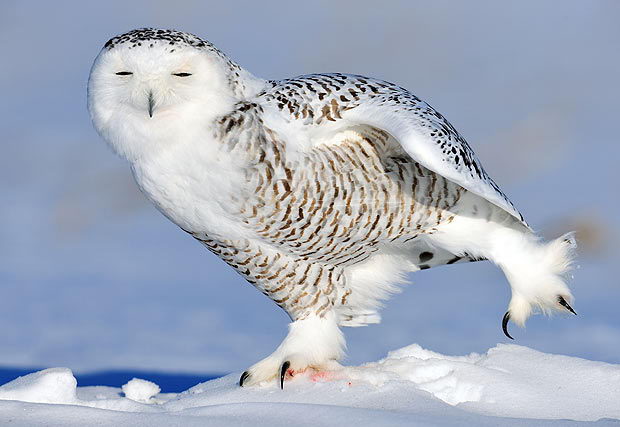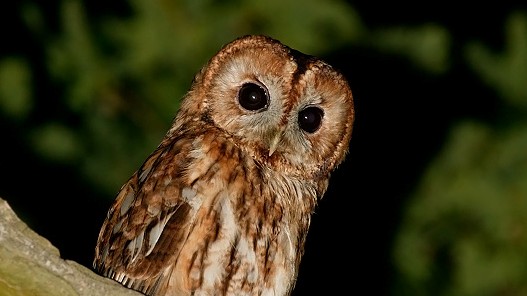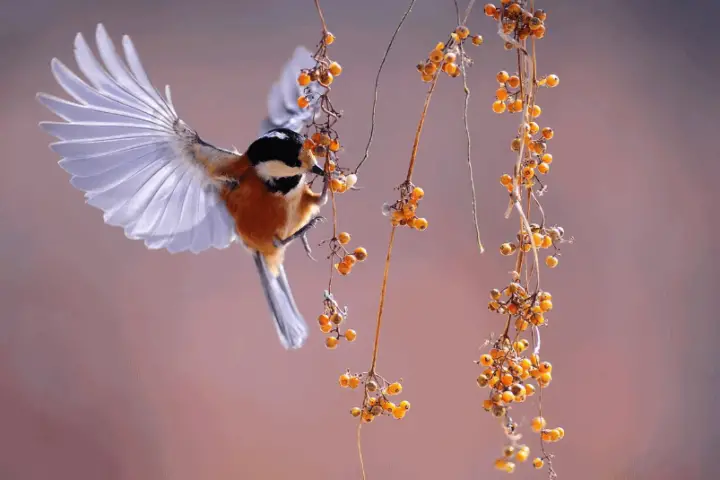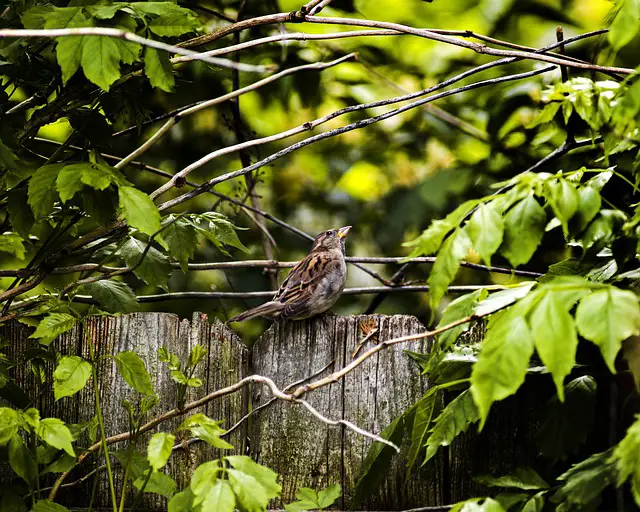It seems like two brownish eyes are looking right at you when you are confronted with one of the snowy owls in the snow, as the rest of the feathery body is lost in the white background. Their white color provides a natural camouflage not only to avoid predators but also to hide from their prey. Snowy owl (Strigiae) is arguably one of the rare birds that live all the time in High Arctic. It is the biggest and the most dominant flying bird all throughout the far north. It is also known as cat owl in some countries perhaps due to its yellowish round-faced eyes. It prefers to stay in tall perch in open ground. The snowy owl chicks begin calling their mother even before hatching. A deep snowy owl’s plumage offers a considerable protection against the extreme cold. Let us study some of the amazing snowy owl facts for kids.
Snowy Owl Facts For Kids
- It stands the heaviest bird in the owl family with females being larger than the males and can weigh more than four pounds.
- The length of the snowy owl measures around 20.5 – 20.8 inches (52 – 71 cm).
- The wingspan of this powerful bird measures around 49.6 – 57.1 inches (126 – 145 cm).
- It has a mean weight of 56.4 – 104.1 oz (1600 – 2950 grams).
- Snowy owl is almost the same size as that of Great Horned Owl.
- They have an acute sense of hearing and their large ears can identify even the slightest movement of lemmings and voles under the snow.
- Thanks to the large yellowish eyes that are affixed right in front of its face which allows it to focus on its prey with both eyes, and also assess precisely the distance for a killing strike.
- The bill is lost in a thick feathery plumage with its front being slightly exposed.
- They have a unique feathery plumage as compared to other flying birds in that their feathers have a tiny slit like a comb, letting it to fly silently.
- Although it can reach a speed of 50 miles per hour (80.5 km/h), snowy owl is generally known for its silent flight than for its high speed.
Read More: What does a Snowy Owl Look Like?
Where Do Snowy Owls Live in the World
Snowy Owls Distribution
If you get a chance of visiting High Arctic and North Pole and probably if you are lucky enough, you may certainly come across some of the snowy owls flying across the tundra in far north of Europe, Greenland, Asia, Canada, and Alaska. They also migrate towards south.
Snowy Owls Habitat
Snowy owls predominantly exist in wide open places which are no dominated by trees. It is because of the fact that snowy owls also sit on ground to hunt. You may come across some of the owl’s habitats while walking through the Great Plains, beach dunes or even airport field.
Read More: How Do Owls Eat their Prey?

What Do Snowy Owls Eat | Snowy Owls Diet
Not many flying birds are able to go by 30 or 40 days without food but snowy owls have adapted this characteristic feature. It can live for about 40 days without eating anything as it primarily relies on carrion. When the prey is scarce it moves towards south. It can seemingly swallow a small rabbit whole. One of its chief preys is lemmings which forms almost 90 percent of owl’s diet.
Snowy owl is a sit-and-wait predator and can hang out for hours before making final flight. It remains alert to strike all the time while watching its prey from a favorite perch. It is actually the search for food that determines the snowy owl’s lifestyle in its harsh habitat. It also relies on number of small animal such as rabbits, weasels, rodents, ducks, geese, grebes, wading birds, and seabirds. It can also take down some of the larger preys especially raccoons, rats, marmots, squirrels, prairie dogs, and muskrats.
Learn more: What do Owls Eat
Snowy Owls Hunt
Unlike other owls that are primarily nocturnal, snowy owl hunts at day and during dim daylight in the Arctic winter. However, most of the time in Arctic tundra is dark therefore snowy owls are often found hunting at night with the help of its binocular vision. It largely preys on carrion but it can hunt animal as big as Arctic fox or seal’s carcass. Not only is it hard to spot by humans, its prey often finds difficult to recognize one because it flies off from over half a mile without making noise. It strikes its prey with its powerful extended talons but for larger prey, it needs to peck on the head to kill.
Snowy Owls Behavior | Snowy Owl Facts For Kids
Snowy owl often goes unnoticed by its prey because of its silent flight; besides it does not often make calls except when claiming its territory in spring or making a nest in summer. Nonetheless, a deep, hollow, and loud hoot is heard within 2 miles around Arctic air when they display call in either of these cases. Females are generally known to produce loud wails if disturbed at the nest and their sounds seems like quacks and barks.
It is too difficult sometimes to get closer to these species as they are shy and can fly off if they sense any human or predator within one mile. Female is more aggressive than male and do whatever they can to protect her nests from intruders. She may disturb it by rolling on the ground as if injured. She displays her forceful attitude by spreading her wings, or stretching her head, or even tearing off the grass and shaking it. Her male, however, continues to fly over the intruder until it leaves.
While it predominantly lives in the frozen tundra north of treeline and frozen ice, snowy owls are basically wanderers and they can move towards south (in Canada) and towards northern United States. Some of these species are also seen in northern Texas and as far south as Virginia. Sometimes, they are sighted on large chunks of ice or ice bergs probably out of bad weather. Owls, however, fancy living in dry, low grounds where rocky hillocks stand are exposed out of snow.
Snowy Owls Nesting and Reproduction | Snowy Owl Facts For Kids
It is the female owl that is responsible for building a nest on a bare ground. It takes her few days to complete the nest; however, these nests can be reused again in the forthcoming years. The male, on the other hand, selects a territory while female chooses a nesting site.
- The clutch size comprises 3 – 11 eggs.
- The width of an owl’s egg measures at 1.8 inches (4.5 cm).
- These white eggs stand around 2.2 inches (5.7 cm).
- The incubation period lasts for about 32 days.
- The nesting period lasts for 18 – 25 days.
- The hatchlings are blind at birth and they usually open their eyes after 4 – 5 days.
- The average lifespan of snowy owl is 8 to 10 years.
Snowy Owl Migration | Snowy Owl Facts For Kids
The North American snowy owls stay in the same breeding grounds all year-round while others move towards northern United States and southern Canada in winter. They are found in large numbers in the northern plains all throughout New York and New England.
Males display dark brown plumage while they are young but it gets whiter as they grow older. Females, however, exhibit dark patterns throughout their lives. Snowy owl is territorial and it does not often allow intruders into its breeding areas. They are known to consume 1,600 lemmings each year.
Conservation Status | Snowy Owl Facts For Kids
Snowy owls were excessively hunted in certain parts of its range as a result of which they are given legal protection. However, it still faces an increasing threat arising out of human encroachment on its remote habitat, which is likely to limit its range reduce its prey. Consequently, snowy owls are now found in regions which are least suitable for their habitat.
Snowy Owls Predators
It goes without saying that snowy owls have few natural predators probably due to its dominant and powerful characteristic feature. Nonetheless, the female owl must need to defend her nest and offspring from any intruders.
Read More: What Eats Snowy Owls?
With the arrival of nesting season, male owls regularly fly around to make sure a nesting site is safe from predators like arctic foxes, gray wolves, jaegers, Skuas, Huskies, avian predators, and corvids.
Snowy owls often encounters with other predators such as Golden Eagles, Great Horned Owls, Peregrine Falcons, Common Ravens, Gyrfalcons, Eurasian Eagle Owls, and Short-eared Owls. Snowy owls usually end up in triumph during combat with these birds but they often lose in conflict with large raptors like Bubo owls.
General Guide to Quick Facts
Length 21 – 26’’
Wingspan 4.7 – 5.4’
Weight 4 – 6 lbs
Breeding season May – September (early)
Maturity Age 3 – 5 years
Number of eggs 2 – 16 (5 – 7 on average)
Incubation Period 30 – 33 days
Number of broods 1 brood
Egg length 5.7 cm
Hatchlings at birth born blind; open their eyes after 5 days
Fledging period 60 days
Primary Diet lemmings, voles, rabbits, hares, seabirds
Breeding Interval 1 year
Population approximately 4,000
Lifespan 8 – 10 years








